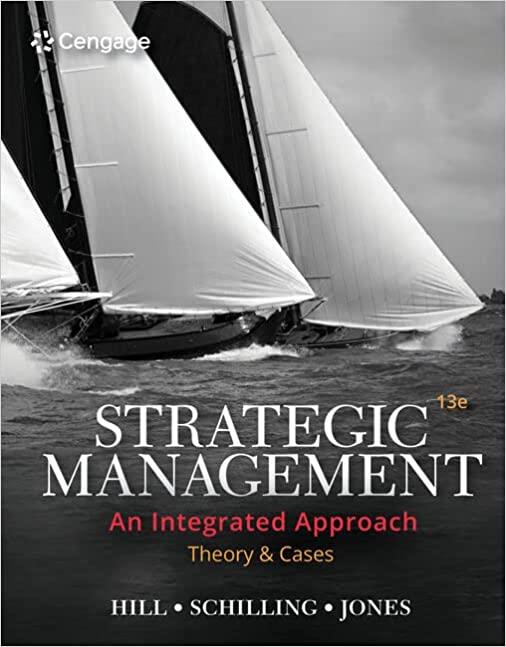Thirty years ago, Starbucks was a single store in Seattles Pike Place Market selling premium-roasted coffee. Today,
Question:
Thirty years ago, Starbucks was a single store in Seattle’s Pike Place Market selling premium-roasted coffee. Today, it is a global roaster and retailer of coffee with more than 24,000 stores, 40% of which are in some 70 countries worldwide. Starbucks set out on its current course in the 1980s, when the company’s director of marketing, Howard Schultz, returned from a trip to Italy enchanted with the Italian coffeehouse experience. Schultz, who later became CEO, persuaded the company’s owners to experiment with the coffeehouse format, and the Starbucks experience was born. The strategy was to sell the company’s own, premium-roasted coffee and freshly brewed, espresso-style coffee beverages, along with a variety of pastries, coffee accessories, teas, and other products, in a tastefully designed coffeehouse setting. From the outset, the company focused on selling “a third-place experience”
(in other words, spending significant time at a place that is neither work nor home), rather than just the coffee. The formula led to spectacular success in the United States, where, within a decade, Starbucks went from obscurity to one of the bestknown brands in the country. Thanks to Starbucks, coffee stores became places for relaxation, chatting with friends, reading the newspaper, holding business meetings, or (more recently) browsing the Web.
In 1995, with 700 stores across the United States, Starbucks began exploring foreign opportunities.
The first target market was Japan. The company established a joint venture with a local retailer, Sazaby Inc. Each company held a 50% stake in the venture, Starbucks Coffee of Japan. Starbucks initially invested $10 million in this venture, its first foreign direct investment. The Starbucks format was then licensed to the venture, which was charged with growing Starbucks’ presence in Japan.
To make sure the Japanese operations replicated the “Starbucks experience” in North America, Starbucks transferred some employees to oversee the Japanese operation. The licensing agreement required all Japanese store managers and employees to attend training classes similar to those given to U.S. employees. The agreement also required that stores adhere to the design parameters established in the United States. In 2001, the company introduced a stock option plan for all Japanese employees, making it the first company in Japan to do so.
Sceptics doubted that Starbucks would be able to replicate its North American success overseas but, by 2014, Starbucks’ had 1,034 stores and a profitable business in Japan.
After Japan, the company embarked on an aggressive foreign investment program. In 1998, it purchased Seattle Coffee, a British coffee chain with 60 retail stores, for $84 million. An American couple, originally from Seattle, had started Seattle Coffee with the intention of establishing a Starbucks-like chain in Britain. By 2014, there were 530 stores in the United Kingdom. In the late 1990s, Starbucks opened stores in Taiwan, China, Singapore, Thailand, New Zealand, South Korea, and Malaysia. In Asia, Starbucks’ frequent strategy was to license its format to a local operator in return for initial licensing fees and royalties on store revenues. As in Japan, Starbucks insisted on an intensive employee-training program and strict specifications regarding the format and layout of the store. By 2002, Starbucks was pursuing an aggressive expansion in mainland Europe, primarily through joint ventures with local companies. Its largest footprints are in Switzerland, France, and Germany.
To succeed in some countries, Starbucks has found that it has to adjust its basic formula to accommodate local differences. France, for example, has a well-established café culture. The French find Starbucks’ lattes too bland, and the espresso too burnt, so Starbucks has had to change the recipe for its drinks to match French tastes. Since French consumers like to sit and chat while they drink their coffee, Starbucks has had to add more seating per store than is common elsewhere.
As it has grown its global footprint, Starbucks has also embraced ethical sourcing policies and environmental responsibility. Now one of the world’s largest buyers of coffee, in 2000 Starbuck’s started to purchase Fair Trade Certified coffee. The goal was to empower small-scale farmers organized in cooperatives to invest in their farms and communities, to protect the environment, and to develop the business skills necessary to compete in the global marketplace. In short, Starbucks was trying to use its influence to not only change the way people consumed coffee around the world, but also to change the way coffee was produced in a manner that benefited the farmers and the environment. According to Starbucks, by 2017, some 95.3% of the company’s coffee was “ethically sourced.”
Questions
1. Where did the original idea for the Starbucks format come from? What lesson for international business can be drawn from this?
2. What drove Starbucks to start expanding internationally?
How is the company creating value for its shareholders by pursuing an international expansion strategy?
3. Why do you think Starbucks decided to enter the Japanese market via a joint venture with a Japanese company? What lesson can you draw from this?
4. Is Starbucks a force for globalization? Explain your answer.
5. When it comes to purchasing coffee beans, Starbucks adheres to a fair-trade program.
What do you think is the difference between fair trade and free trade? How might a fairtrade policy benefit Starbucks?
Step by Step Answer:

Strategic Management Theory And Cases An Integrated Approach
ISBN: 9780357033845
13th Edition
Authors: Charles W. L. Hill, Melissa A. Schilling, Gareth R. Jones





